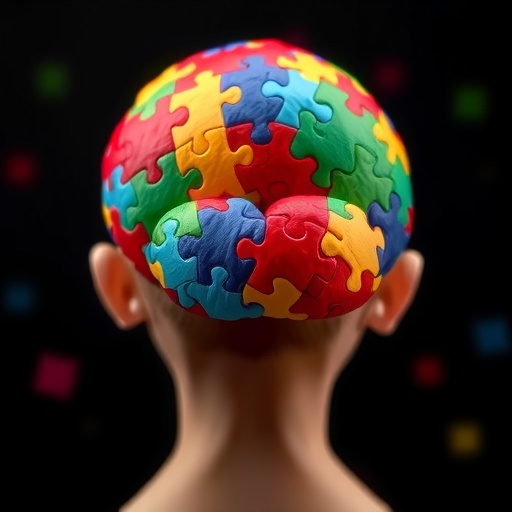Recent groundbreaking research reveals that autism’s polygenic architecture and developmental trajectories exhibit significant variation depending on the age at diagnosis, providing a fresh and nuanced understanding of this complex neurodevelopmental condition. This landmark study, published in Nature in 2025 by Zhang, Grove, Gu, and colleagues, unearths compelling evidence that earlier- and later-diagnosed autism represent partly distinct etiological pathways shaped by different genetic factors. These insights challenge the conventional unitary view of autism, highlighting how genetic heterogeneity corresponds with developmental timing and clinical diversity, thereby reshaping future research and clinical practice.
The investigation leverages a rich array of birth cohorts, genome-wide association studies (GWAS), and polygenic risk scoring techniques to dissect the genetic underpinnings related to age at autism diagnosis. Notably, the authors quantify SNP-based heritability for age at diagnosis at approximately 11%, indicating meaningful but incomplete genetic influence. Crucially, the genetic correlation between earlier- and later-diagnosed autism is moderate, confirming that these are not simply different phenotypic expressions of a single genetic entity but rather reflect at least two partly independent polygenic latent factors influencing developmental outcomes.
Furthermore, the study integrates longitudinal behavioral data from multiple population samples, tracing socioemotional and neurodevelopmental trajectories with the Strengths and Difficulties Questionnaire (SDQ). The polygenic scores for early- versus late-diagnosed autism diverge markedly in their relationship to changes in SDQ total difficulties scores, reinforcing the premise that these two autism variants follow different developmental courses. This developmental-genetic dissonance underscores that age at diagnosis does not merely reflect diagnostic practice or environmental variables but points robustly toward differing underlying biology.
The implications of this research extend beyond autism itself to broaden our concept of neurodevelopmental disorders and their interplay with mental health. Later-diagnosed autism shows stronger genetic correlation with attention deficit hyperactivity disorder (ADHD)—a link weak or absent in earlier diagnosis profiles—and this variation is congruent with the temporal emergence of related neuropsychiatric symptoms. Within-family genetic transmission analyses further corroborate these findings by demonstrating preferential over-transmission of ADHD risk alleles among individuals diagnosed later with autism, illuminating a window into complex pleiotropic genetic mechanisms.
Adding another dimension to these findings, the study reveals that the polygenic risk factor for later-diagnosed autism aligns with elevated mental-health difficulties such as anxiety and depression. This evidence lends genetic-based credence to epidemiological observations that individuals receiving autism diagnoses later in life often confront greater co-occurring psychiatric challenges. This intersection of genetic and clinical traits importantly calls for precision in interpreting sex and gender differences within autism since females typically receive later diagnoses, suggesting that previously reported sex disparities may partly result from age-related diagnostic biases rather than purely biological distinctions.
However, the authors carefully delineate the study’s limitations, notably the modest proportion of variance explained by common genetic variation, which points to myriad environmental, cultural, and potentially unmeasured biological contributors influencing age at diagnosis. Additionally, reliance on parent-reported SDQ scores limits capturing the full spectrum of core autistic traits, and the exclusive focus on European ancestries curtails the generalizability across global populations. The researchers emphasize the need to pursue more comprehensive, diverse longitudinal cohorts and genetically stratified designs to deepen the mechanistic understanding.
Despite these constraints, the study’s demonstration of a two-latent-trait polygenic model disrupts conventional autism genomics paradigms. It resolves prior inconsistencies in genetic correlations observed across GWAS datasets by contextualizing differences within age-at-diagnosis strata. Notably, combining data from various cohorts with differing diagnosis ages explains why some autism GWAS show stronger overlaps with ADHD and why others do not, clarifying a long-standing conundrum in psychiatric genetics.
This reconceptualization carries profound implications for clinical practice as well. Recognizing early- and late-diagnosed autism as genetically and developmentally heterogeneous could refine diagnostic criteria and guide tailored interventions. It suggests that early identification efforts might benefit from distinct biomarkers and therapeutic strategies compared to cases diagnosed in adolescence or adulthood. Moreover, disentangling genetic confounding associated with age at diagnosis can enhance the accuracy of research into sex and gender differences, co-occurring mental health conditions, and longitudinal outcomes.
Looking forward, this paradigm invites a reexamination of how neurodevelopmental trajectories are studied, urging a shift toward models that accommodate continuous gradients rather than discrete categories. It encourages integrating genetic profiles with lifetime phenotypic evolution, expanding beyond static diagnostic labels to embrace developmental complexity. Such approaches may illuminate hidden subtypes within autism and other neuropsychiatric disorders, yielding precision medicine strategies aligned with individual genomic and phenotypic landscapes.
In sum, Zhang et al.’s study represents a pivotal advance that refines the genetic architecture of autism, emphasizing that age at diagnosis is a critical axis of heterogeneity with meaningful biological, clinical, and mental health correlates. This nuanced genetic insight not only elucidates why the autism spectrum is so phenotypically diverse but also charts a course for future research to unravel the intricate developmental paths shaping this multifaceted condition. By bridging genomics, developmental epidemiology, and psychiatric phenotyping, it redefines how the scientific and medical communities conceptualize and approach autism.
Subject of Research: Genetic and developmental heterogeneity in autism spectrum disorder as influenced by age at diagnosis.
Article Title: Polygenic and developmental profiles of autism differ by age at diagnosis.
Article References:
Zhang, X., Grove, J., Gu, Y. et al. Polygenic and developmental profiles of autism differ by age at diagnosis. Nature (2025). https://doi.org/10.1038/s41586-025-09542-6
Image Credits: AI Generated
Tags: age at autism diagnosisautism genetics researchclinical implications of autism researchdevelopmental trajectories in autismdistinct etiological pathways in autismgenetic correlation in autism subtypesgenetic heterogeneity in autismheritability of autism diagnosis agelongitudinal behavioral data in autismneurodevelopmental outcomes in autismpolygenic architecture of autismSNP-based heritability in autism





